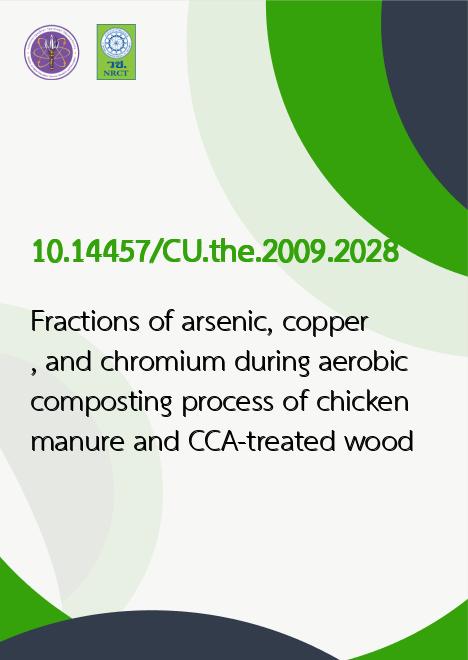
|
Fractions of arsenic, copper, and chromium during aerobic composting process of chicken manure and CCA-treated wood |
|---|---|
| รหัสดีโอไอ | |
| Title | Fractions of arsenic, copper, and chromium during aerobic composting process of chicken manure and CCA-treated wood |
| Creator | Neeraya Rattanasatchan |
| Contributor | Somjai Karnchanawong |
| Publisher | Chulalongkorn University |
| Publication Year | 2552 |
| Keyword | Heavy metals -- Environmental aspects, Arsenic, Copper, Chromium, Soils -- Heavy metal content |
| Abstract | To evaluate the fractions of heavy metals during aerobic composting process of 4 piles, each comprising chicken manure and 4 different proportions of CCA-treated wood shavings (0%, 33%, 66%, and 100% dry weight of CCA-treated wood in the wood material added in the compost mix). Each pile was composted in a 1-cb.m wood box with passive aeration. The temperature at the central portion of each pile was measured daily while the compost characteristics and germination index using Brassica campertris var. chinensis were monitored on samples collected weekly. The changes in heavy metals based on Cu, Cr and As fractionations during aerobic composting process were determined by a sequential extraction procedure. After the maturity of compost reached, the mature compost were amended with soil in 1:2 ratios for planting the Brassica campertris var. chinensis for 45 days. The characterizations of plant and variation of heavy metals in soil and plant during 45 days of planting were investigated. The results showed that the microorganisms could degrade the organic matter in all compost piles even for the highest proportion of CCA-treated wood in the compost mixture. During the composting process, the variation patterns of temperature, pH, organic carbon, total nitrogen, total volatile solid and C/N ratio of four piles gradually decreased and were stable during the composting period of 95 to 140 days. The average values of those parameters of four piles were not significantly different. During composting, the pile with high CCA-treated wood portions had significantly lower values of GI. The concentrations of Cu, Cr and As increased with time of composting. The results of the sequential extraction showed that during the composting process, As was mainly redistributed into the mobile fraction, whereas Cu and Cr had an affinity for the stable fraction. After amending the compost with soil, the Cr and Cu were present in the less available forms for soil organisms and plants whereas As was mainly in the mobile phase, in which considered as the bioavailable element. These three metals found in plants were associated with water soluble form. The accumulations of Cu and Cr mostly were found in the root part whereas As mostly was found in the above-ground parts. The plant could grow without any effect in the soil amended compost containing 0 and 33% of CCA-treated wood. It could be concluded that the presence of CCA treated wood in the compost mix did not have any influence on the decomposition of organic matter in the composting process. However, the high proportion of CCA-treated wood in the compost mix could have an effect on the phytotoxicity. The maximum proportion of CCA-treated wood shaving used in the compost mixture without phytotoxicity effect was 33% of total wood shaving weight |
| URL Website | cuir.car.chula.ac.th |